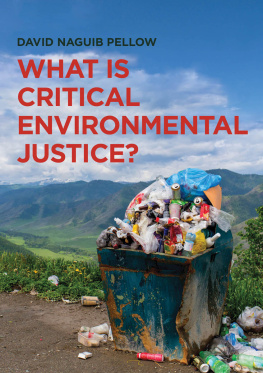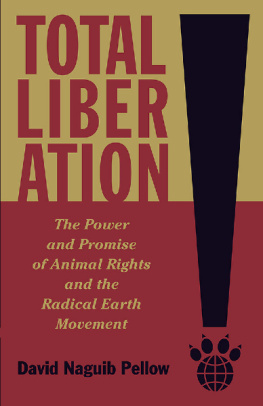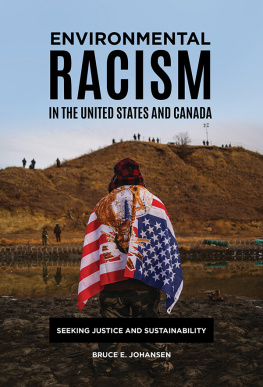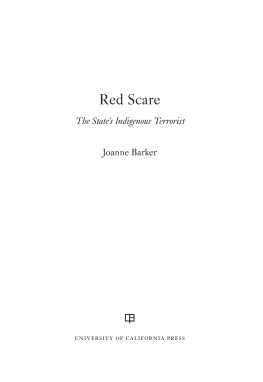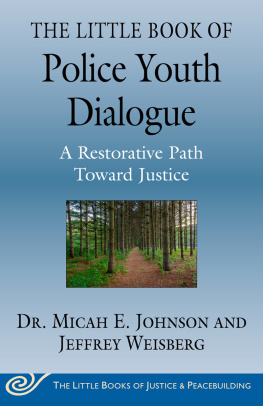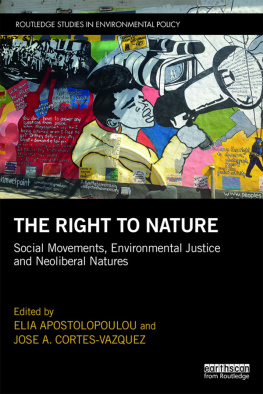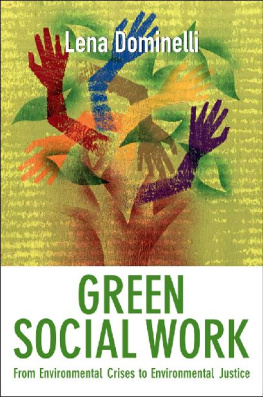Contents
Guide
Pages

Dedication
To Sun-Hee and Jin-Young thank you for giving me hope and sharing your love
To Y.I.M.J.R.S.I. thank you for guiding and connecting all of us
What is Critical Environmental Justice?
David Naguib Pellow
polity
Copyright David Naguib Pellow 2018
The right of David Naguib Pellow to be identified as Author of this Work has been asserted in accordance with the UK Copyright, Designs and Patents Act 1988.
First published in 2018 by Polity Press
Polity Press
65 Bridge Street
Cambridge CB2 1UR, UK
Polity Press
101 Station Landing, Suite 300
Medford, MA 02155, USA
All rights reserved. Except for the quotation of short passages for the purpose of criticism and review, no part of this publication may be reproduced, stored in a retrieval system or transmitted, in any form or by any means, electronic, mechanical, photocopying, recording or otherwise, without the prior permission of the publisher.
ISBN-13: 978-1-5095-2532-4
A catalogue record for this book is available from the British Library.
The publisher has used its best endeavours to ensure that the URLs for external websites referred to in this book are correct and active at the time of going to press. However, the publisher has no responsibility for the websites and can make no guarantee that a site will remain live or that the content is or will remain appropriate.
Every effort has been made to trace all copyright holders, but if any have been inadvertently overlooked the publisher will be pleased to include any necessary credits in any subsequent reprint or edition.
For further information on Polity, visit our website: www.politybooks.com
Acknowledgments
As much as I would like to take full credit for this project, it turns out that researching, writing, and publishing a book is always a collective effort. I am indebted to a great number of people for sharing their ideas, criticisms, guidance, and labors to make this work possible. Students who provided me with critical assistance along the way include: Marjan Abubo, Mark Avalos, Reid Bongard, Martha Escobar, Sheila Estrada, Denise Garcia, Erin Hoekstra, Sanna King, Rebecca Kinney, Annie Milburn, Ivan Rodriguez, Alison Thompson, Ashkaun Shaterian, Yue (Rachel) Shen, and Amy Tam.
I want to thank my colleagues, students, and friends at UCSB who have warmly welcomed me into the Santa Barbara community with open arms and so much support. They include: Peter Alagona, Celia Alario, Javiera Barandiaran, Vilna Bashi-Treitler, Joe Blankholm, Eileen Boris, Angela Boyd, Oliver Chadwick, Alenda Chang, Grace Chang, Maria Charles, Jia-Ching Chen, Jordan Clark, Mariah Brennan Clegg, David Cleveland, Carla DAntonio, Mona Damluji, Hilal Elver, Richard Falk (who gave me really helpful feedback on ), Ingrid Feeney, Richard Flacks, John Foran, Diane Fujino, Helene Gardner, Hunter Gelbach, Avery Gordon, Corrie Grosse, Hahrie Han, Robert Heilmayr, Cami Helmuth, Ken Hiltner, Cheryl Hutton, Melody Jue, Terence Keel, Ed Keller, Zachary King, Renan LaRue, Theo LeQuesne, Mel Manalis, Matto Mildenberger, Dena Montague, Erinn OShea, Michelle Oyewole, Sameer Pandya, Tristan Partridge, Simone Pulver, Martin Rodriguez, Josh Schimel, Daniela Soleri, Jeffrey Stewart, Leah Stokes, Susan Stonich, Ra Thea, Jennifer Tyburczy, Richard Widick, Bob Wilkinson, Emily Williams, and Eric Zimmerman.
A big thanks to friends and colleagues at the University of Minnesota (Cawo Abdi, Ron Aminzade, Liz Boyle, Bruce Braun, Vinay Gidwani, Michael Goldman, Teresa Gowan, George Henderson, and Rachel Schurman), the University of California at Davis (Thomas Beamish, Vicky Smith, Julie Sze, Jonathan London, Lindsey Dillon, Jacque Leaver, and Ingrid Behrsin), Vanderbilt University (David Hess, Zdravka Tzankova, Holly McCammon, Andr Christie-Mizell, Rachel McKane, Anna Jacobs, Magdalena Sudibjo, Lacee Satcher, Larry Isaac, Kate Pride Brown, Lijun Song, and Anne Wall), and the University of Michigan (Dorceta Taylor, Rebecca Hardin, Sonia Joshi, Ivette Perfecto, and Paul Mohai) for offering space to share and receive feedback on many of the ideas contained in this volume.
Colleagues spread far and wide across the country who were also instrumental in this effort include Hollie Nyseth-Brehm, Joni Adamson, Kari Norgaard, Shannon Bell, Julian Agyeman, Traci Brynne Voyles, Laura Pulido, Sylvia Hood Washington, Beth Schaefer Caniglia, Manuel Vallee, Beatrice Frank, Brian Mayer, J. Timmons Roberts, David Takeuchi, Sara Bruya, Yonette Thomas, Samantha Teixeira, Mia White, Anthony Nocella II, Ryan Holifield, Panagioti Tsolkas, and Mike Ewall.
And at Polity Press, my editor Jonathan Skerrett and Editorial Assistant Amy Williams have been wonderful partners throughout this process, and I am grateful to the extraordinary anonymous reviewers of the manuscript, and Ann Klefstad for her outstanding copy editing. I also have to extend a big thank you to Emma Longstaff who, while at Polity some years back, extended a generous invitation to me and came up with the initial idea that eventually resulted in this book.
Critical Environmental Justice Studies
Michael Brown was an African-American teenager living in Ferguson, Missouri. On August 9, 2014, police officer Darren Wilson shot and killed him, sparking worldwide outrage at the seemingly unending series of police shootings of African-Americans. When protesters took to the streets of cities around the US and the world to declare that Black Lives Matter, they and those who were the targets of police shootings were frequently referred to as animals. Juana Gutirrez is the daughter of a Mexican farmer; she immigrated to the US at age fifteen. She started an organization called Mothers of East Los Angeles (MELA), which has fought to keep prisons from being built in her city and around the state of California. Nicholas Morrissey was an inmate at a state prison in LaBelle, Pennsylvania, who suffered from a chronic illness he believes was caused by the fact that the prison is next to a coal ash dump. Foad al-Amodi is president of the fishermens syndicate in Khan Younis, a town in the Palestinian Occupied Territories. His livelihood is threatened because the fish that he and his customers depend upon are dying from exposure to the massive volume of sewage that flows into the Mediterranean Sea a result of the Israeli blockade of the Gaza Strip, which has prevented the purchase of much-needed equipment to upgrade Gazas waste management system. Havah Ha-Levi was a Jewish Israeli woman who lived in a kibbutz near an old Palestinian Arab village, Sarkas, which was destroyed and converted into a garbage dump. In her memoir she writes, Yet I remember. I testify. State-sanctioned police killings of black people. Prisons and jails. The Israel/Palestine conflict. Each of these cases reveals how human suffering and social inequality also are sites where that pain is intimately linked to the harm visited upon fragile ecosystems and other animals. And each of these cases speaks to the ways that ordinary people and, in some cases nonhumans, have worked for environmental and social justice.
Human societies have always been deeply interconnected with our nonhuman relations and with ecosystems, but today those relationships are witnessing greater frictions, tensions, and harms than ever before, prompting scholars to label this epoch the Anthropocene because of the dominance of the human species on planet Earth. And while that dominance has led to incalculable damage to ecosystems and to human societies as well, the opportunities for addressing these problems and challenges are within our grasp, if we only dare to break out of conventional modes of thinking and action. The harms suffered by ecosystems today are closely linked to and mirror the harms experienced by the most marginalized human beings across the planet what many scholars call the problem of

